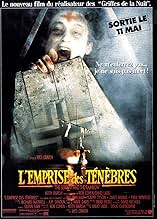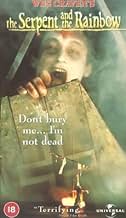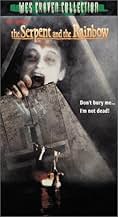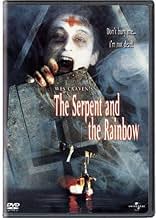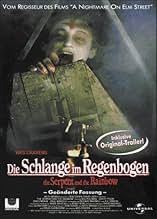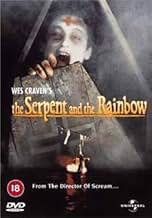VALUTAZIONE IMDb
6,4/10
28.823
LA TUA VALUTAZIONE
Aggiungi una trama nella tua linguaAn anthropologist goes to Haiti to research a drug that makes someone appear dead by suspending all vital signs.An anthropologist goes to Haiti to research a drug that makes someone appear dead by suspending all vital signs.An anthropologist goes to Haiti to research a drug that makes someone appear dead by suspending all vital signs.
- Regia
- Sceneggiatura
- Star
- Premi
- 1 candidatura in totale
Jaime Pina
- Julio
- (as Jaime Piña Gautier)
Kimberleigh Aarn
- Margrite
- (as Kimberleigh Burroughs)
Recensioni in evidenza
Much to my surprise, this film was actually an excellent horror flick, one that I plan to watch again some day. I am glad a friend of mine recommended the movie to me, I am just hoping others will find the time to look into it.
Even more, if the story actually is based on a "true story", I will shudder at the thought of it...
Even more, if the story actually is based on a "true story", I will shudder at the thought of it...
10EdgarST
I remember watching "The Serpent and the Rainbow" in a cinema when it opened 12 years ago, and although it did not strike me as a masterpiece, I never forgot it. I had always had a memory of it as a good horror film, but tonight I saw it again on television and I was impressed about how good it is. One may associate Wes Craven with "Scream" or "A Nightmare on Elm Street", but this one is certainly one of his best films. I still see it as an adventure film with horror elements, but this time I found it full of style -a touch of documentary approach, clever use of colorful locations, good handling of massive scenes with many unprofessional extras, attractive ethnic art direction, a bit of grand guignol in some performances (mainly Zakes Mokae), humor and a sensitive and sympathetic approach to a different culture. Many times one sees American films dealing with others' cultural aspects -such as political affairs and religion-, without any respect or concern. It is true that "The Serpent and the Rainbow" is not a serious drama about people's revolt, or a tract on synchretic religions (such as Cuban santería, Haitian voodoo or Brazilian candomblé), but both aspects are not just décors, but elements well integrated to the story in its own terms -that is, in a low budget feature, whose main objective is to entertain and scare the audience. The so-called "South" is such an exotic locale for most First World filmgoers, that cultural "details" often pass unnoticed, because these persons seem to be too obsessed with their own "cinematic hedonism". Craven knows it, and that is why he makes foreign tourists applaud when they have seen a real possession, thinking it is just part of Paul Winfield's show. One of the reasons that this film is good is the script. Someone mentions in another comment how cleverly it introduces more than one level in a single scene: for example, when Dennis and Marielle are looking for Christophe in a cemetery, they not only meet grave robbers for scaring effect, but they also discuss about the possibility that Marielle is using Dennis to obtain funds for her hospital, and the scene fulfills its expectation: they find Christophe, who tells them about the mysterious 'powder'. What turns off some viewers -and myself, in a way- is the cinematic forms that take all the things dealing with energy and human capacity for evil. They are sometimes too gross, others just plain funny or ridiculous; but this is a Craven film, and they did not detract me from the main objective I mentioned earlier. Besides, there are other things I enjoyed watching the film again. First, to see once again the Bill Pullman whom I used to enjoy so much (remember the dumb blond in "Ruthless People"?) when he was beautiful and had not turned into the dull American president of "Independence Day." I also recognized elements I've witnessed. A lot of the things that you see and hear in this film are not just fiction (after all it is based on a "true" story): they are all part of many Caribbean cultures -from the sensuality of the islanders, to the rite in the river, or the powder itself. And believe me: the powders work! Not only for making zombies, but also for many other things. Don't ask me how, I do not know how they do it, but I have seen them work (in Cuba -no joke intended)! So beware.
One of Wes Craven's best, "Serpent and the Rainbow" is as much a psychological thriller as a horror movie. Some horror fans may find it too slow (it takes its sweet time to come to a climax) but it's worth it... the journey is entertaining and interesting. This is a polished, professionally filmed movie with higher production values than the average for its genre.
I've never seen a film before that went quite so in-depth into the subject of voodoo. Filmed on location in Haiti, this movie goes into a lot of detail about various voodoo practices and introduces the voodoo versions of the good and evil magician, the houngon and the bocor. If you have any interest at all in this subject matter (or the supernatural in general), I recommend the movie on that basis alone.
Acting is uniformly solid throughout, if nothing really outstanding. We do not come to care very deeply about these characters, so their trials, tribulations and deaths do not bother us much... but Craven's attention to detail really shows, and there isn't a moment of this movie that lacks entertainment value. 7/10.
I've never seen a film before that went quite so in-depth into the subject of voodoo. Filmed on location in Haiti, this movie goes into a lot of detail about various voodoo practices and introduces the voodoo versions of the good and evil magician, the houngon and the bocor. If you have any interest at all in this subject matter (or the supernatural in general), I recommend the movie on that basis alone.
Acting is uniformly solid throughout, if nothing really outstanding. We do not come to care very deeply about these characters, so their trials, tribulations and deaths do not bother us much... but Craven's attention to detail really shows, and there isn't a moment of this movie that lacks entertainment value. 7/10.
First I have to mention that while the book (The Serpent and the Rainbow by Wade Davis) is infinitely better and deeper than the movie that shares its name, comparing the two is unfair. The audience is informed that the movie was "inspired" by the content of the book, for whatever interpretation you give inspired. What makes the book more interesting, aside from it being a true documentary, is how it balances light and shadow in much the way the Vodoun religion balances both. This film may leave you thinking that Haiti is a horrible place filled with monsters and boogeymen, and I don't think that's a fair estimation.
The film confuses many things and ideas which I feel should have been explained. Not everyone is an ethnoreligionist, after all. Totems, houngans, hounfours, mambos, bokors, le Bon Dieu, and the Amazon shaman are just mentioned in passing as if this is everyday vocabulary to the audience. The character of Marielle is presented as a dedicant of the goddess (loa) Erzulie. Well, this is a nice touch, but what of Damballah and his consort Aida-Wedo--the original serpent and the rainbow? And what about the man dressed as a skeleton in an obvious tribute to Baron Samedi--yet the Baron is never mentioned. What really made me chuckle is how Alan's totem saves the end, a totem we had only seen in glimpses without the concept of a power animal ever being explained.
Through in the confusion of the collapse of the Duvalier government and we have the perfect recipe for movie mayhem. Oh, come on...you just knew the overthrow of Duvalier had to work itself in here somewhere, right? We must have the obligatory "I am an American citizen--you cannot touch me" scene when dealing with the so-called Third World.
Bill Pullman was entirely wrong as the protagonist. I just found it unbelievable that this man could find his way out of a Happy Meal box let alone 200 miles of Amazon rainforest. He is abrasive and unpolite, two things which are professional suicide for anybody dealing in international cultures. All right, one can allow for a certain degree of cynicism on his part, but I find it difficult to believe that a man of his caliber and academic background would be fool enough to shoot his mouth off as he does.
Watch this film with an acrostic eye. It isn't a bad film, in spite of the faults I personally found with it. Just watch it cautiously. If it whets your interest, definitely go check out the Davis book.
The film confuses many things and ideas which I feel should have been explained. Not everyone is an ethnoreligionist, after all. Totems, houngans, hounfours, mambos, bokors, le Bon Dieu, and the Amazon shaman are just mentioned in passing as if this is everyday vocabulary to the audience. The character of Marielle is presented as a dedicant of the goddess (loa) Erzulie. Well, this is a nice touch, but what of Damballah and his consort Aida-Wedo--the original serpent and the rainbow? And what about the man dressed as a skeleton in an obvious tribute to Baron Samedi--yet the Baron is never mentioned. What really made me chuckle is how Alan's totem saves the end, a totem we had only seen in glimpses without the concept of a power animal ever being explained.
Through in the confusion of the collapse of the Duvalier government and we have the perfect recipe for movie mayhem. Oh, come on...you just knew the overthrow of Duvalier had to work itself in here somewhere, right? We must have the obligatory "I am an American citizen--you cannot touch me" scene when dealing with the so-called Third World.
Bill Pullman was entirely wrong as the protagonist. I just found it unbelievable that this man could find his way out of a Happy Meal box let alone 200 miles of Amazon rainforest. He is abrasive and unpolite, two things which are professional suicide for anybody dealing in international cultures. All right, one can allow for a certain degree of cynicism on his part, but I find it difficult to believe that a man of his caliber and academic background would be fool enough to shoot his mouth off as he does.
Watch this film with an acrostic eye. It isn't a bad film, in spite of the faults I personally found with it. Just watch it cautiously. If it whets your interest, definitely go check out the Davis book.
A researcher (Bill Pullman) goes to Haiti in order to find a "zombie drug" that can give someone the appearance of death, when in actuality their body is at its lowest functioning. They may not breathe, or bleed, but they are not truly dead. The researcher and the company he works for hope to use it as an anesthetic.
The film started as a book of the same name by anthropologist Wade Davis, who is probably the world's authority on voodoo and zombies. Discussions were made to have Peter Weir direct and/or Mel Gibson star, but obviously this never happened. The script found its way to Wes Craven, and Bill Pullman (at that point a young rising star) was given the lead.
Author Wade Davis was on set from the very beginning and wanted to make the best film he could regardless of who the director would be. He notoriously did not like the way it went, and Bill Pullman says that both he (Pullman) and Wes Craven were disappointed, too, because they wanted a more serious angle and the studio (Universal) was pushing for a horror story. In retrospect, Davis seems to have become more accepting of the film and does not hold it against Craven. In fact, he praises many of the scenes for their authenticity, especially in comparison to other attempts at making voodoo films.
The filming took place throughout 1987, and the political tensions were getting nasty in Haiti. Dictator Jean-Claude "Baby Doc" Duvalier becomes part of the plot, which makes this not just an anthropological horror film, but a political one, too. If people are able to look past the horror aspects, there is actually an important cultural document here.
While the film is quite interesting for a variety of reasons, it starts off slow, and does not really pick up until the second half. Bill Pullman's character is the only one you are going to get to know from this film, and the only character who gets a lot of development. The natives seem very flat, and most just come across as wanting to kill Pullman. In a way, this makes sense, because this story is essentially told from his point of view.
Bill Pullman reflected years later, "I don't think any other movie I've done is as adventurous as this one." He did most of his own stunts, met with real voodoo priests and took part in a variety of activities that may not be your typical Hollywood situation. One scene was filmed in an actual Dominican grave. He confirms that writer Richard Maxwell had to be admitted to an asylum after consulting with a voodoo priest.
Fans of Craven ought to check this one out. It does not have the in-your-face slasher horror of Craven's "Nightmare on Elm Street", "Scream" or "Last House on the Left". But it is not intended to be. This is a film built on atmosphere, and in many ways a horror more realistic than any he had ever done before.
As always, the must-have version was released by the fine folks at Scream Factory. Those interested in the movie will have to watch the 25-minute "making of", which has interviews with cinematographer John Lindley, the father-son special effects team of Lance and Dave Anderson, Wade Davis, and some re-used audio from Pullman.
The audio commentary is disappointing. On the one hand, it is the first time the film has had a commentary track, so credit must be given to Scream Factory for giving the disc the attention that past companies (specifically Image and Universal) failed to do. But the commentary with Bill Pullman only goes halfway through the film, with no one left to take his place. The real tragedy is in the passing of Wes Craven (the disc is dedicated to him), who could have offered more insight.
There will undoubtedly never be a better release of this essential Wes Craven film... unless someone manages to convince Bill Pullman to hand over all the vacation footage he shot with his wife on set!
The film started as a book of the same name by anthropologist Wade Davis, who is probably the world's authority on voodoo and zombies. Discussions were made to have Peter Weir direct and/or Mel Gibson star, but obviously this never happened. The script found its way to Wes Craven, and Bill Pullman (at that point a young rising star) was given the lead.
Author Wade Davis was on set from the very beginning and wanted to make the best film he could regardless of who the director would be. He notoriously did not like the way it went, and Bill Pullman says that both he (Pullman) and Wes Craven were disappointed, too, because they wanted a more serious angle and the studio (Universal) was pushing for a horror story. In retrospect, Davis seems to have become more accepting of the film and does not hold it against Craven. In fact, he praises many of the scenes for their authenticity, especially in comparison to other attempts at making voodoo films.
The filming took place throughout 1987, and the political tensions were getting nasty in Haiti. Dictator Jean-Claude "Baby Doc" Duvalier becomes part of the plot, which makes this not just an anthropological horror film, but a political one, too. If people are able to look past the horror aspects, there is actually an important cultural document here.
While the film is quite interesting for a variety of reasons, it starts off slow, and does not really pick up until the second half. Bill Pullman's character is the only one you are going to get to know from this film, and the only character who gets a lot of development. The natives seem very flat, and most just come across as wanting to kill Pullman. In a way, this makes sense, because this story is essentially told from his point of view.
Bill Pullman reflected years later, "I don't think any other movie I've done is as adventurous as this one." He did most of his own stunts, met with real voodoo priests and took part in a variety of activities that may not be your typical Hollywood situation. One scene was filmed in an actual Dominican grave. He confirms that writer Richard Maxwell had to be admitted to an asylum after consulting with a voodoo priest.
Fans of Craven ought to check this one out. It does not have the in-your-face slasher horror of Craven's "Nightmare on Elm Street", "Scream" or "Last House on the Left". But it is not intended to be. This is a film built on atmosphere, and in many ways a horror more realistic than any he had ever done before.
As always, the must-have version was released by the fine folks at Scream Factory. Those interested in the movie will have to watch the 25-minute "making of", which has interviews with cinematographer John Lindley, the father-son special effects team of Lance and Dave Anderson, Wade Davis, and some re-used audio from Pullman.
The audio commentary is disappointing. On the one hand, it is the first time the film has had a commentary track, so credit must be given to Scream Factory for giving the disc the attention that past companies (specifically Image and Universal) failed to do. But the commentary with Bill Pullman only goes halfway through the film, with no one left to take his place. The real tragedy is in the passing of Wes Craven (the disc is dedicated to him), who could have offered more insight.
There will undoubtedly never be a better release of this essential Wes Craven film... unless someone manages to convince Bill Pullman to hand over all the vacation footage he shot with his wife on set!
Lo sapevi?
- QuizNewly wed, Bill Pullman's wife was invited to be an extra and appears on screen as the blonde who pushes a long needle through a willing man's cheek.
- BlooperAt about the 1:05 mark a computer screen shows the word "specimen" misspelled as "speciman".
- Citazioni
Dennis Alan: Don't let them bury me! I'm not dead!
- Curiosità sui crediti[Opening card] In the legends of voodoo the Serpent is a symbol of Earth. The Rainbow is a symbol of Heaven. Between the two, all creatures must live and die. But because he has a soul Man can be trapped in a terrible place Where death is only the beginning. The following is inspired by a true story.
- Versioni alternativeUK video and DVD versions are cut by 5 seconds by the BBFC to remove shots of cock-fighting (illegal animal cruelty).
- Colonne sonoreMadame Marcel
Performed by Le Roi Coupe Cloue
Courtesy of Chancy Records
I più visti
Accedi per valutare e creare un elenco di titoli salvati per ottenere consigli personalizzati
Dettagli
Botteghino
- Budget
- 7.000.000 USD (previsto)
- Lordo Stati Uniti e Canada
- 19.595.031 USD
- Fine settimana di apertura Stati Uniti e Canada
- 5.848.700 USD
- 7 feb 1988
- Lordo in tutto il mondo
- 19.595.031 USD
- Tempo di esecuzione1 ora 38 minuti
- Colore
- Mix di suoni
- Proporzioni
- 1.85 : 1
Contribuisci a questa pagina
Suggerisci una modifica o aggiungi i contenuti mancanti

Divario superiore
What is the Italian language plot outline for Il serpente e l'arcobaleno (1988)?
Rispondi




